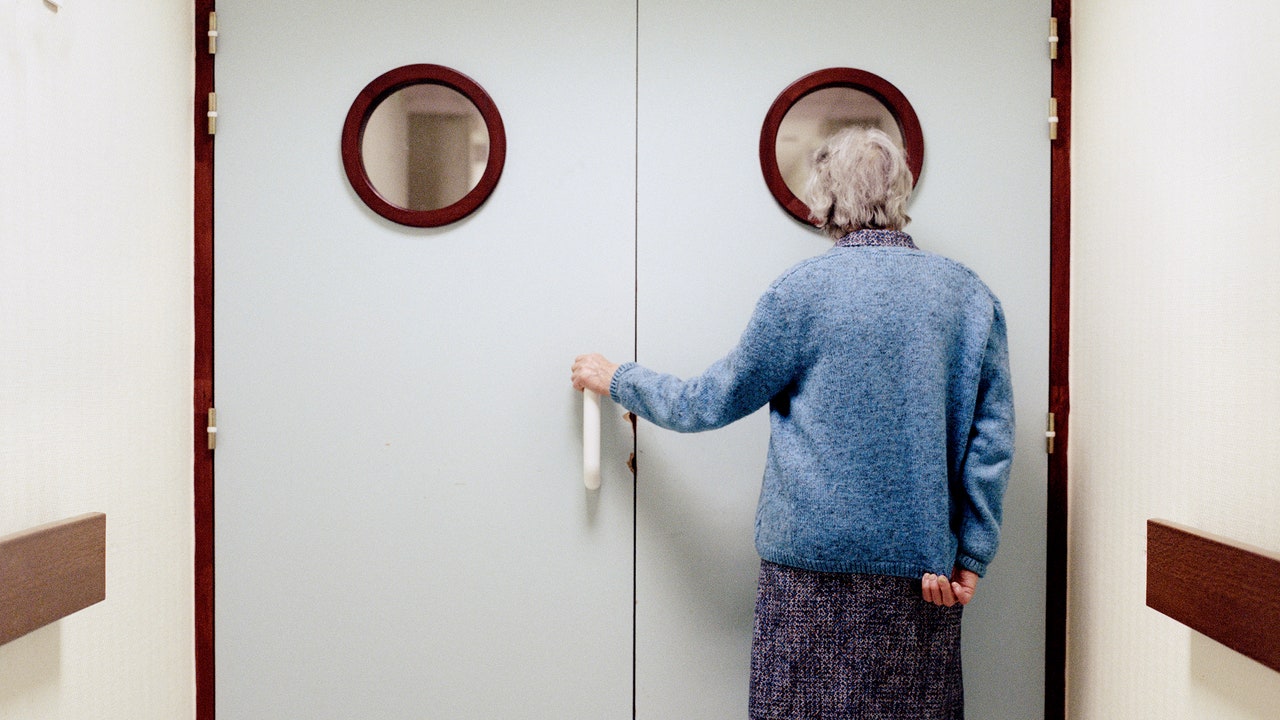How to Find a Missing Person with Dementia

Nancy Paulikas and her husband, Kirk Moody, arrived at the Los Angeles County Museum of Art on October 15, 2016. Museumgoing had been among the couple’s many hobbies in retirement, along with travel, hiking, and gardening. But, since Paulikas’s diagnosis of early-onset Alzheimer’s, the year before, it had become hard to say how an outing might go. A day earlier, they had spent a difficult afternoon at a park with old friends who hadn’t realized how quickly Paulikas, a former software engineer, had deteriorated. “Nancy didn’t want to have anything to do with it. She was walking away from the group, and she was upset,” Moody recalled. “It was a real horror show for several of our friends. They were, like, Oh, my goodness. That’s not Nancy.”
But, at the museum, her demeanor was calm. With the couple were Moody’s relatives, who were visiting from Colorado. A photograph taken at lunch shows Paulikas, who was then fifty-five, with glasses and curly, shoulder-length brown hair, looking at the camera with a quizzical half smile. Moody had helped her choose that day’s jeans and a bright-red top, with blue Skechers sneakers that were comfortable for walking.
After several hours at the museum, they prepared to leave. Moody escorted Paulikas to a women’s restroom on the museum’s second floor and then looked for the men’s room, which turned out to be situated a floor below. He darted quickly down a nearby staircase, used the bathroom, and returned to meet Paulikas. She wasn’t there.
The advice typically given to patients and caregivers of people in the early stages of Alzheimer’s is that it’s not a question of if a person with the condition will wander away, but when. Moody had heard this advice, but wandering hadn’t particularly worried him. Paulikas had grown more attached to her husband as the disease progressed, becoming anxious if they were separated and reluctant to leave home without him. It was hard to imagine her simply walking away. Moody looked through the galleries of the museum’s Ahmanson building, expecting with every turn to spot his wife. He alerted museum security and enlisted his family’s help. They fanned out across the sprawling grounds of Hancock Park, which houses the museum and the nearby La Brea Tar Pits. Midday traffic rushed past.
While her family searched, an office-tower security camera captured images of Paulikas striding purposefully westward on Wilshire Boulevard, pausing only at crosswalks. (The footage appears in “Where Is Nancy?,” a 2020 documentary by Thiago Dadalt.) Less than an hour after Moody last saw her, another camera recorded a grainy image of Paulikas walking southwest down the busy thoroughfare of McCarthy Vista, her eyes ahead and her steady pace unchanged.
On the day she disappeared into Los Angeles, Paulikas was one of nearly five and a half million people in the U.S. with Alzheimer’s disease, the most common cause of dementia. (Today, that number is more than six million.) In becoming lost, she experienced one of the disease’s most common symptoms: the unravelling of the brain’s navigational systems. According to some estimates, more than sixty per cent of people with Alzheimer’s disease will wander away from home or a caregiver, or become lost when an abrupt bout of confusion propels them from an otherwise familiar setting. Such episodes can be distressing for caregivers, given that lost individuals with dementia can be particularly hard to find. Becoming lost also carries with it the ominous possibility of injury or death. And yet a person with Alzheimer’s can’t simply be locked in at home. The loss of dignity and quality of life would be intolerable, and, as many caregivers discover, people with dementia can quite suddenly outmaneuver even those safety measures adopted with their input and consent. Wandering lays bare a painful truth about life with dementia: risk and freedom are inextricably intertwined.
In 1901, a fifty-one-year-old woman named Auguste Deter arrived at a Frankfurt mental hospital after months of increasingly serious bouts of amnesia, paranoia, and auditory hallucinations. “I have lost myself,” she told Alois Alzheimer, her physician. Alzheimer’s medical notes contained hand-drawn illustrations; after Deter’s death, in 1906, they showed the neurofibrillary tangles that he found throughout her brain.
Though the speed of its progression varies from patient to patient, the condition now known as Alzheimer’s disease generally takes a predictable path through each brain. Beta-amyloid and tau proteins often first invade the entorhinal cortex in the medial temporal lobe before assailing the adjoining hippocampus. We use both brain areas to travel through the world: grid cells in the entorhinal cortex help track our positions as we move through space, while the hippocampus is involved in conceptualizing where things are in relation to our bodies.
Years can pass between the toppling of the first neurological domino and the onset of the short-term memory problems that typically prompt worried patients or their families to seek medical advice. Karen Duff, the director of the Dementia Research Institute at University College London, told me that an Alzheimer’s-afflicted brain wasn’t unlike a buggy G.P.S. device that, with increasing frequency, blanks out parts of the map. The mental location of an intended destination—Walmart, say, or a room in one’s home—suddenly disappears, along with the memory of its adjacent landmarks.
Wandering is a logical response to this illogical and unsettling experience. A person might walk to escape what suddenly feels like alien territory, perhaps in the hope of figuring out where they’ve been stranded. In the later stages of the disease, a short-circuiting hippocampus may abruptly swap an old memory into the time line: caregivers are often told to take note if a person starts talking urgently about having to get to work, pick up children, or fulfill some other obligation that was part of a long-ago daily routine.
Spells of disorientation can come on suddenly and depart just as quickly. Wendy Mitchell, a former administrative worker in the U.K.’s National Health Service, was diagnosed with early-onset Alzheimer’s at the age of fifty-eight; one day shortly before her diagnosis, she looked up from her desk and no longer recognized her handwriting on the files, her name on the door, or the office around her. “It wasn’t just confusion. It was a complete blank. A black hole,” she wrote, in a 2018 memoir. Terrified, Mitchell acted instinctively—she rose from her chair and started walking. “Office doors were open either side of the corridor,” she recalled. “Inside the rooms, heads I didn’t recognize looked down at paperwork. I dreaded them—whoever they were—looking up and being greeted by the blankness on my face. . . . I didn’t want anyone to speak to me, to pull me into their world, because I didn’t know that world, I didn’t know the people in it.”
People who are lost often make poor and self-defeating decisions. Fear hijacks executive functioning; the brain floods with cortisol and adrenaline. The fight-or-flight instinct takes over, and a lost person keeps moving, sometimes at a run, despite the fact that rescue is more likely if she stays put. Mitchell walked straight down the corridor and through the double doors at its end, then pushed through an unlocked door directly in front of her. It happened to open into the bathroom—a dead end. Because she could not go any farther, she entered a stall and sat down on a closed toilet lid. After some time, her confusion abated, and she once again understood where she was.
In 1992, Robert Koester, a specialist in lost-person behavior, published a research paper analyzing the stories of twenty-five missing persons with dementia. The project morphed into what is now the International Search & Rescue Incident Database—a collection of more than two hundred and fifty thousand case files describing missing persons of all kinds. According to Koester’s data, three-quarters of people with dementia who are lost long enough to be reported missing are found within a mile and a half of their original locations. On foot, they tend to travel in relatively straight lines, and they often continue travelling until they collapse from exhaustion, which in the majority of cases happens within an hour. Alternatively, they may plunge into a part of the landscape from which they can’t escape—a hedge, a ditch, a body of water—often with fatal results. In Koester’s database, ninety-five per cent of people who are found within twenty-four hours of going missing are still alive; after ninety-six hours, the figure falls to forty-six per cent.
Lost people with dementia tend to have few possessions with them. They don’t discard clothes or supplies along the way, which searchers might be able to find. If they do encounter passersby, they rarely ask for help or disclose their plight—perhaps because they don’t recognize themselves as lost and in need of assistance, or because they are frightened by their surroundings or too ill to speak. For similar reasons, ninety-nine per cent do not respond to their name when called.
“I have a hypothesis,” Koester told me. “One of the first things we learn as humans is nonverbals. One of the last things to go in dementia is nonverbals. I’m sure you haven’t had this experience, but try shouting somebody’s name for four hours. In the first couple of minutes, you may be able to sound pretty friendly—you know, ‘Staaaanley! Stanley!’ ” he said in a singsong voice. “After a while it just gets, like, ‘Stanley!’ ” A person with dementia, responding to the nonverbal cues in a searcher’s voice, may be frightened by its strained, desperate tones.
A great deal of anti-wandering advice is offered to caregivers who are already stretched thin. Keep the environment calm and restful; have distractions ready; hide car keys, hats, coats, purses or other objects that might inspire departure; camouflage doors with removable curtains, or paint them to match the wall. And yet a 2019 study that reviewed various deterrent and distraction methods found no evidence that any of them reliably worked.
Wandering is most frequent in the middle stages of Alzheimer’s, when the disease has progressed far enough to disrupt an individual’s cognitive functions but not enough to impair their motor skills. Many patients report depression, restlessness, and anxiety during this time, both as a direct consequence of the changes in their brains and as an understandable response to the frustrations of navigating life without the aid of consistent memory. But there can be good days as well. Maintaining a regular routine that includes activities such as walks, visits with friends, or time outside in the garden can help counterbalance the disease’s inevitable oscillations. These same activities can also create opportunities for a person to slip away unnoticed. But it’s neither possible nor advisable to prevent every situation in which a person with dementia could go wandering.
Meredeth Rowe, a researcher at the University of South Florida who studies wandering and dementia, underscored the nuanced nature of the problem. “The vast majority of individuals with dementia who go missing are located and safely returned in a short window of time,” she said. Most people are found, she went on, “by family or community members who recognize the person and initiate the process of getting them back home.” It’s possible, therefore, to approach the problem of wandering not just by trying to prevent it but by preparing for its occurrence. Prisca Mendez Asaro, a former caregiver in Kansas City, Missouri, described taking her mother for a walk around the neighborhood; Mendez Asaro knocked at each door, introduced her mother and explained that she had dementia, and passed along her own phone number and address so that neighbors could contact her if they saw her mother alone and in distress. “Some people struggle with, ‘Do I really want the neighbors to know what’s going on with me?’ ” Mendez Asaro, who now works with the Alzheimer’s Association, said. “But I felt that the safety and security for her and me was more important than trying to hide it. The interesting thing is, as I was telling the neighbors—I mean, the stories of ‘Oh, my aunt has it’ or, you know, ‘My best friend’s mother has it.’ All of these stories started coming out.” Not long after their outing, Mendez Asaro found her mother trying to pry an anti-wandering safety alarm from the wall with a butter knife.










